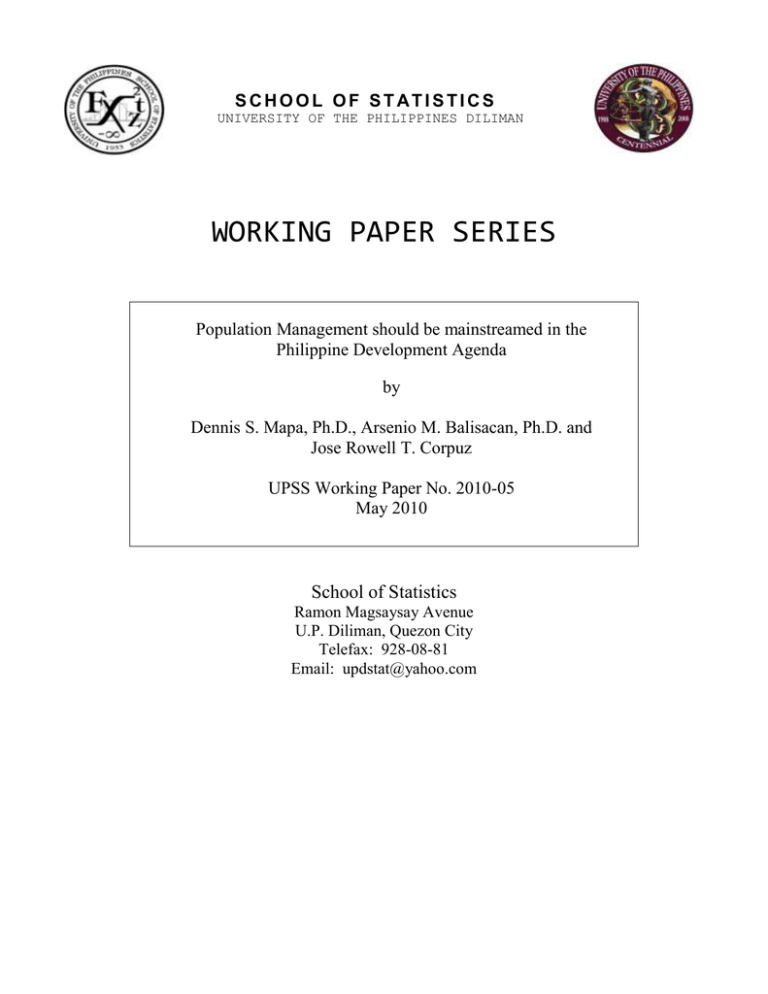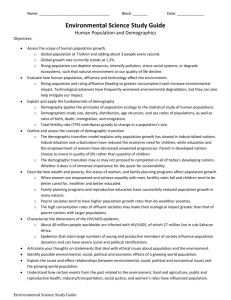WORKING PAPER SERIES
advertisement

SCHOOL OF STATISTICS UNIVERSITY OF THE PHILIPPINES DILIMAN WORKING PAPER SERIES Population Management should be mainstreamed in the Philippine Development Agenda by Dennis S. Mapa, Ph.D., Arsenio M. Balisacan, Ph.D. and Jose Rowell T. Corpuz UPSS Working Paper No. 2010-05 May 2010 School of Statistics Ramon Magsaysay Avenue U.P. Diliman, Quezon City Telefax: 928-08-81 Email: updstat@yahoo.com Population Management should be mainstreamed in the Philippine Development Agenda1 Dennis S. Mapa2, Arsenio M. Balisacan3 and Jose Rowell T. Corpuz4 Abstract The performance of the Philippine economy has been hindered by the country’s bourgeoning population due to its rapid population growth. For the last decade, the Philippines had the highest annual population growth rates in the Southeast Asian region. In 2009, it has become the second most populous country in the region with a population of more than 92 million, next only to Indonesia. Unfortunately, these have resulted to forgone economic growth, losing the chance to improve the poverty situation in the country. Thus, it is imperative to speed up the demographic transition in the country through proactive government population management policies aimed at harvesting the demographic dividends quickly. By performing simulation analyses on total fertility rate (TFR) under two scenarios, it was shown that the Philippines can hardly experience in the near future the Goldilock period, or the generation when fertility rate is neither too high nor too low, especially when the government does nothing to address the problem. Under the business-as-usual scenario, the Goldilock period will be reached by year 2030, or twenty years from now. In the second scenario where the government intervention targets only the households with unwanted fertility, the Goldilock period will be achieved ten years earlier, or in about 2020. Key words: Demographic Transition, Goldilock Period, Fertility Rate I. Demographic Transition and the Demographic Dividend The rapid population growth in the Philippines over the last several decades has hindered the country’s economic development. For the period 2000 - 2009, the Philippines had one of the highest population growth rates in the Southeast Asian region 1 2 3 4 This paper is a product of the study Can Population Management be Mainstreamed in the Philippine Development Agenda? by the Asia Pacific Policy Center (APPC) in collaboration with the Philippine Center for Population and Development (PCPD). Associate Professor and Director for Research, School of Statistics and Affiliate Associate Professor, School of Economics, University of the Philippines, Diliman, Quezon City and Research Fellow, AsiaPacific Policy Center (APPC). Email address: cdsmapa@yahoo.com. Professor of Economics, University of the Philippines, Diliman, Quezon City and President, AsiaPacific Policy Center (APPC). Research Associate, Asia-Pacific Policy Center and Ph.D. Candidate, School of Economics, University of the Philippines, Diliman, Quezon City 1 at 2.04 percent (as of 2007) and the second largest population of more than 92 million in 2009, next only to Indonesia. It comes as no surprise that in 2006, 32.9 percent of our population, or an equivalent of 28 million Filipinos were living below the poverty line (NSCB, 2006). The core idea which links population and economic growth is demographic transition described as “a change from a situation of high fertility and high mortality to one of low fertility and low mortality.” A country that enters into a demographic transition experiences sizable changes in the age distribution of the population and this affects economic growth. Unlike its Southeast and East Asian neighbors, the Philippines failed to achieve a demographic transition similar to what its neighbors had in the past three decades. All of these countries' (including the Philippines) mortality rates broadly declined at similar rates. In the Philippines however, fertility rates dipped slowly; so while population growth rates substantially dropped to below 2 percent a year in other countries (such as Thailand, Indonesia, and Vietnam), the Philippines’ high population growth rate of more than 2 percent per year hardly changed. Studies show that demographic transition accounts for a significant portion (about one-third) of the economic growth experienced by East Asia’s economic “tigers” during the period 1965 to 1995 (Bloom and Williamson, 1997). The effect of the demographic transition on income growth is known as the first demographic dividend. In the course of the demographic transition, countries experience an increasing share of the working age population relative to the total population and this creates favorable effects on the per capita income. In addition to the first dividend, there is another positive effect on economic growth and is referred to as the second demographic dividend. This dividend results when individuals accumulate savings in their working years to serve as buffer during their retirement years. While accumulation of capital can be used to deal with the lowering of income in the older ages, this capital also influences economic growth. As Mason (2007) points out, it is when society increases its saving rate that results in a more rapid economic growth – creating the second demographic dividend. Mason estimated 2 that first and second demographic dividend account for 37.7% of the yearly average per capita growth rate of Japan from 1950 to 1980. II. The Goldilock Period and High Economic Growth As countries move from large families (high fertility rate) and poverty into small families (low fertility), high economic growth and ageing, they pass through what is called a Goldilock period: a generation or two in which fertility rate is neither too high nor too low (The Economist, October 2009). This fertility rate consistent with stable population is about 2.1 (also known as the replacement rate of fertility). The fall to replacement fertility is a unique and precious opportunity for higher economic growth. The figures in Table 1 show the Total Fertility Rates (TFR) for select countries in East Asia from the period 1960 to 2006. The table shows that poor and rich countries are racing though the demographic transition and achieving the replacement fertility rate of 2.1: Singapore in the mid-1970s, South Korea in mid-1980s, Thailand in 1990, Vietnam and Myanmar in 2006. It is interesting to note that only three (3) countries in the table have TFR of more than 3.0 in 2006: the Philippines (3.30), Lao PDR (3.29) and Cambodia (3.27). Moreover, Lao PDR and Cambodia have reduced their TFR much faster than the Philippines, having TFRs of about 6 during the 1990s compared to the Philippines’ TFR of 4.31. It will be disheartening to see that years down the road, Lao PDR and Cambodia will enjoy the dividend associated with the demographic transition and transform their economies to the level that will improve the lives of millions of their citizens, while the Philippines continues to languish in the high population growth-high poverty incidence trap. Table 1. Total Fertility Rate (TFR) for Selected East Asian Countries Country South Korea ASEAN 5 Singapore Year 1960 5.67 1970 4.53 1980 2.83 1990 1.59 2000 1.47 2006 1.13 5.45 3.09 1.74 1.87 1.44 1.26 3 Thailand Indonesia Malaysia Philippines Rest of SE Asia Vietnam Myanmar Brunei Darussalam Cambodia Lao PDR 6.40 5.52 6.81 6.96 5.33 5.35 5.47 6.20 3.21 4.36 4.21 5.17 2.11 3.10 3.68 4.31 1.86 2.42 2.96 3.62 1.85 2.23 2.65 3.30 6.05 6.06 6.83 6.29 6.42 5.89 5.98 5.62 5.81 6.42 4.97 4.54 4.04 5.84 6.41 3.62 3.38 3.20 5.73 6.08 1.90 2.41 2.58 3.96 4.03 2.08 2.10 2.34 3.27 3.29 TFR is the average number of children a woman would bear during her lifetime given current agespecific fertility rates Source: World Development Indicators 2008 The results of the study by Mapa and Balisacan (2004), using cross-country data from 80 countries over the period 1975 to 2000, showed that the difference in the population structure of Thailand and the Philippine accounts for about 0.768 percentage point of forgone average annual growth (missed first dividend) for the Philippines from 1975 to 2000. This forgone growth accumulates to about 22 percent of the average income per person in the year 2000. It is even more impressive when translated into monetary values. It would have meant that rather than a per capita GDP of US$993 for the year 2000, Filipinos would have gotten US$1,210 instead. Moreover, poverty incidence would have been reduced by about 3.6 million. Less Filipinos would have been counted among the poor by the year 2000. Speeding up the Demographic Transition The effects of rapid population growth (or high fertility level) on economic growth and poverty have been carefully studied, documented and quantified by researchers and the results point to the same conclusion: that rapid population growth in poor and developing countries hinders economic development which pushes the next generation into the poverty trap. The Philippines appears to be the only country in all of Asia, and perhaps one of the few in the world, where the population issue remains controversial to this day. 4 The main policy issue that should be addressed immediately is how to harvest the demographic dividend quickly. Advocates of speeding the demographic transition placed emphasis on the need for public effort to accelerate voluntary reduction in fertility rates as soon as possible. Sachs (2008) pointed out that “demographic transitions, where they have occurred, have typically been accelerated and even triggered, by proactive government policies.” Thus, there is a need to influence public policies that play an important role in assisting, particularly the poor households, in achieving a voluntary reduction in fertility rates. This will relieve the direct pressures of population growth, particularly unwanted fertility estimated to contribute about 16% of the future population growth, through direct population policies. The current strategy of reducing total fertility rate by relying on the Natural Family Planning (NFP) methods clearly will not bring us to the Goldilock period at a faster pace. Even the Health Secretary Esperanza Cabral realized this when she acknowledged that “even as population growth is coming down, it is not coming down at the rate necessary to improve the socioeconomic status of the country.” (Interview, Philippine Daily Inquirer, February 28, 2010) III. Simulation Analysis of Total Fertility Rate (TFR) under Two Scenarios The slow pace by which the total fertility rate has been reduced (from 6.96 in 1960 to 3.30 in 2006 or a measly 1.6 percent per year) can be attributed to a lack of concrete and proactive government policies on population management aimed at accelerating the demographic transition. What then will the TFR of the country in the future under the same set of policies (e.g. gearing towards the use of the natural family planning methods)? When do we achieve the Goldilock period that is conducive for higher economic growth under the status quo? 5 An essential variable that reduces fertility rate is income. Studies have shown that as the income of the household increases, the fertility rate tends to decrease. Figure 1 shows the relationship between regional per capita income (in natural logarithm) and the regional total fertility rates from 1993 to 2006. The TFR regional data is generated from the National Demographic and Health Survey (NDHS) while the regional per capita income came from the Regional Gross Domestic Product (RGDP) report of the National Statistical Coordination Board (NSCB). The figure shows that as the income of the regions increase, the TFR decrease. It should be noted that no region has reach a TFR of 2.1. Figure 1. Relationship between TFR and per capita GDP by Philippine regions (1993-2006) 6.0 Regional TFR 5.0 4.0 3.0 2.0 8.5 9.0 9.5 10.0 10.5 Regional GDP per capita (in logarithmic scale) total factor productivity predicted tfr Using the relationship between per capita income and TFR, Mapa, Lucagbo and Ignacio (2010) built an econometric model to determine the effect of income on TFR, controlling for other factors such as education of the household head and labor force participation of women, among others. The study shows that increasing per capita income by one percent reduces TFR by 0.025 per year. Using the results of the study, simulation analysis was made to plot the path of the country’s TFR under two scenarios. 6 Scenario 1 is the business as usual scenario where TFR is reduced mainly as a result of increasing income. This scenario assumes that the country’s GDP is growing at an average of 4 percent per year (and thus per capita GDP is growing at 2 percent per year, net of the population growth of about 2 percent per year). Scenario 2 assumes the same average income growth of 4 percent plus government intervention to relieve the population pressure from unwanted fertility, estimated to account for 16 percent of the future population growth. To be more realistic, scenario 2 further assumes that only 90 percent of the households with unwanted fertility will be covered by the government program. The current and future TFRs under these two scenarios are presented in Figure 2. Using the 2008 TFR of 3.3 as base value, in the business as usual scenario 1, the Goldilock period will be reached by 2030, or twenty years from now. In the second scenario where government intervention targets only households with unwanted fertility, the Goldilock period will be achieved 10 years early or in about 2020. Figure 2. Total Fertility Rates under Two Scenarios 3.5 Total Fertility Rate 3.0 2.5 2.0 1.5 1.0 0.5 0.0 2008 2010 2020 Year scenario 1 scenario 2 2030 The same simulation exercise was made for the poorest 40 percent of the households, where the TFRs are high. In 2008 for example, while the overall TFR of the 7 country is 3.30, the TFR of the poorest 20 percent (or the bottom quintile) is at 5.20 and the second quintile at 4.20. The values in Table 2 show that, under the status quo, the households in the bottom quintile will not experience the Goldilock period in this generation. The TFR of the poorest 20 percent of the households 30 years from now (or in 2040) will be at 3.47. This estimated TFR in 2040 will still be higher than the recorded TFR of Thailand in 1980 at 3.21. Under scenario 2 where government intervenes through proactive population management policies, the TFR of the poorest 20 percent will be at a manageable level of 2.31 by the year 2040. For households in the second quintile, the TFR will still be at 2.47 in year 2040 under the status quo, while the Goldilock period will be achieved earlier in year 2030 when the TFR for this group is projected to be at 2.07. Table 2. Total fertility rates of the second and bottom quintile under two scenarios 2008 2010 2020 2030 2040 Scenario 1 4.20 4.09 3.55 3.01 2.47 Scenario 2 4.20 3.16 2.62 2.07 1.53 Scenario 1 5.20 5.10 4.55 4.01 3.47 Scenario 2 5.20 3.93 3.39 2.85 2.31 Second quintile Bottom quintile IV. Mainstreaming Population Management in the Development Agenda Addressing the poverty problem is the single most important policy challenge facing the country today and one cannot ignore the growing number of empirical evidence linking population growth on the one hand and poverty on the other. Development policies aimed at addressing the alarming poverty incidence in the country must include measures that will manage the country’s bourgeoning population and bring 8 down the fertility rate to a level that is conducive to higher economic growth. Policy makers must address the country’s rapid population growth head-on though proactive government policies, such as the Reproductive Health (RH) bill. The failure to pass the RH bill in the 14th Congress is very unfortunate for the damage that a rapid population growth will bring to this generation and the next are irreversible. We simply cannot afford to have millions of Filipinos go through the vicious cycle of high fertility and poverty: high fertility rate prolongs poverty in households and poor households contribute to high fertility rates. Government must intervene to break this cycle by creating policies that will increase the capacity of women to participate in the labor market, invest in health to decrease child mortality and enhance education, particularly of women. These are the policies that have been found successful in reducing fertility rates in households. At the same time, government must also directly intervene by, for example, providing contraceptive services to poor households that cannot afford these contraceptive services for, without such government support, the fertility rates in these households will remain high and unmanageable condemning them to poverty. We cannot afford to ignore the population issue because population gravely affects our country’s growth and development and as it is, we are paying a high price for our rapid population growth. REFERENCES Bloom, D.E. and Williamson, J.G. (1997). “Demographic Transitions and Economic Miracles in Emerging Asia.” Working Paper 6268, National Bureau of Economic Research, November 1997. Mapa, D.S., Lucagbo, M.D.C. and Ignacio, C.S. (2010). Is Income Growth Enough to Reduce Fertility Rate in the Philippines? Empirical Evidence from Regional Panel Data. . A paper presented at the Philippine Population Association (PPA) Annual Scientific Conference on February 4 to 5, 2010 at the Heritage Hotel, Pasay City. Mapa, D. S. and A. Balisacan (2004). “Quantifying the Impact of Population on Economic Growth and Poverty: The Philippines in an East Asian Context.” In: 9 Population and Development in the Philippines: The Ties That Bind (Ed Sevilla, L.A.). AIM Policy Center, Makati City. Mason, Andrew (2007). “Demographic Dividends: The Past, the Present and the Future.” In Mason, A. and Yamaguchi, Mitoshi (eds.). Population Change, Labor Markets and Sustainable Growth: Towards a New Economic Paradigm. ELSEVIER. National Statistical Coordination Board (2006), Website, www.nscb.gov.ph Philippine Daily Inquirer (2010). Interview with Health Secretary Esperanza Cabral by Jerry E. Esplanada , February 28, 2010 issue. Sachs, J. D. (2008). Common Wealth: Economics for a Crowded Planet. Penguin Books. The Economist (2009). “Falling fertility: How the population problem is solving itself.” October 31 to November 06, 2009 issue. 10






